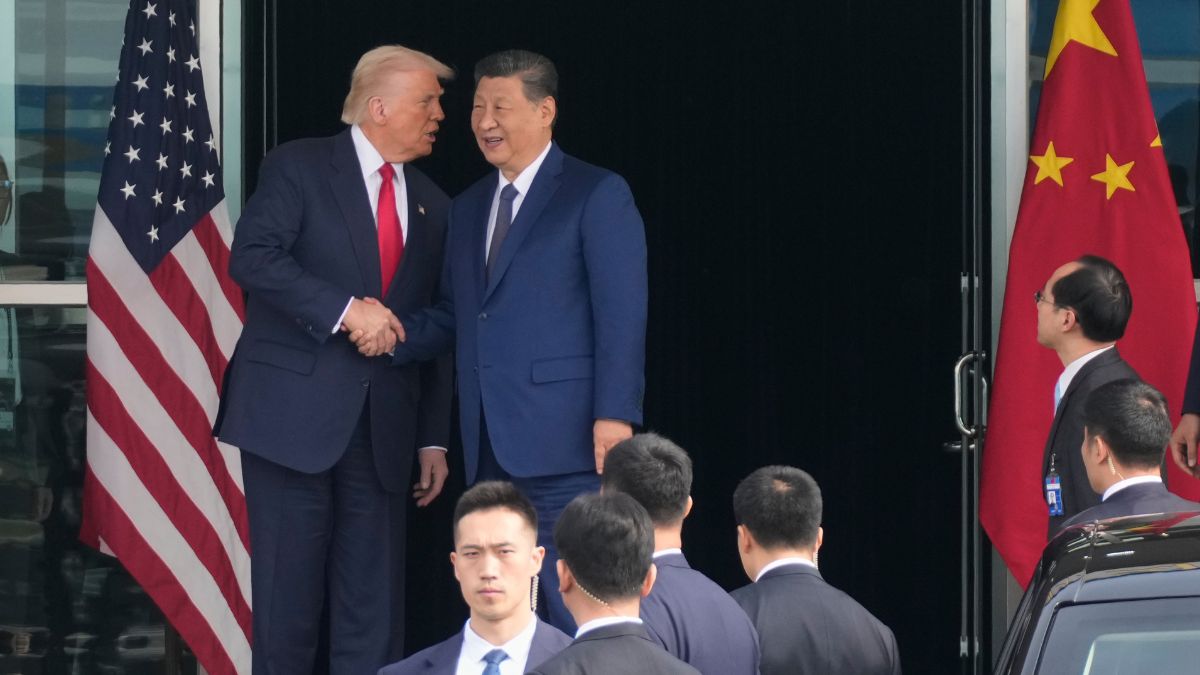Moments after US–China trade talks concluded in Busan, Air Force One departed for Washington while Chinese President Xi Jinping’s motorcade sped toward the Asia-Pacific Economic Cooperation (APEC) summit 80 kilometres away, a scene that vividly symbolised the shifting centre of global economic power.
While US President Donald Trump wrapped up his whirlwind 24-hour visit to South Korea and headed home, Xi arrived at the regional forum to a chorus of applause from delegates. The contrast was unmistakable: America’s “America First” retreat met China’s pitch for global leadership through multilateralism.
Xi steps into the vacuum
Xi’s arrival at APEC highlighted Beijing’s bid to occupy the diplomatic space left by Washington’s withdrawal from collective global forums. Addressing the leaders of 21 Pacific Rim economies, Xi urged them to “practice true multilateralism” and strengthen the World Trade Organisation (WTO) as the foundation of the international trading system.
“The more turbulent the times, the more we must work together,” Xi said during the summit’s opening session in the South Korean city of Gyeongju. He called for updated global trade rules to reflect the “changing times” and better protect the interests of developing nations, a thinly veiled reference to Washington’s protectionist stance.
In remarks sent to the APEC CEO Summit, Xi promised that China would remain open to investment, describing participation in the Chinese market as “investing in the future.”
Washington steps back
Trump’s absence from APEC, an institution co-founded by the US in 1989 to promote regional economic integration is considered a striking reversal of American engagement in Asia. The US president has long dismissed large multilateral gatherings as inefficient “talk shops.” Instead, he has favoured bilateral negotiations and tariffs, upending decades of US commitment to free trade.
During his brief Asia tour, Trump concluded a 100-minute meeting with Xi in Busan, describing it as a “roaring success.” He announced plans to ease certain tariffs on China, while Beijing agreed to resume imports of American soybeans and relax curbs on rare earth exports.
Yet, while the truce soothed markets rattled by months of trade tension, Trump’s immediate departure for Washington where he later hosted the White House’s Halloween party—sent a different signal.
Impact Shorts
More ShortsU.S. Treasury Secretary Scott Bessent represented Washington at APEC, insisting that America’s participation remained “strong and robust,” though the optics suggested otherwise. Analysts say the decision to skip the forum cements an image of US disengagement from the multilateral order it once shaped.
China’s long game
For Beijing, the optics could hardly be better. Xi’s back-to-back engagements from the ASEAN summit in Kuala Lumpur, where Chinese Premier Li Qiang signed an upgraded China–ASEAN free trade agreement to APEC in Gyeongju in an aggressive diplomatic push.
“The upgraded free trade agreement only reinforces China’s dominant posture in terms of regional economic engagement,” said Yun Sun, co-director of the East Asia Program at the Stimson Center. “In comparison, US bilateral deals are much more circumstantial and limited.”
China’s strategy goes beyond rhetoric. Its latest five-year plan explicitly prioritises “safeguarding the multilateral trading system” and deepening cross-border economic flows. Xi also used his APEC platform to call for stability in supply chains, a direct challenge to US efforts to decouple from Chinese manufacturing.
Eric Olander of the China Global South Project said Beijing’s goal is clear: “Through expanded trade, infrastructure development and logistics, China aims to bind this region to its economy so deeply that it becomes impossible for countries to disentangle themselves.”
Regional unease and realpolitik
Despite Xi’s confident tone, many Asian nations remain wary. Japan’s new Prime Minister Sanae Takaichi and Canadian Prime Minister Mark Carney, both of whom met Xi on the sidelines—raised difficult issues, from trade disputes to geopolitical tensions.
Japan’s foreign ministry spokesperson Toshihiro Kitamura voiced concerns about Beijing’s “weaponisation” of trade, pointing to China’s latest restrictions on rare earth exports. “China tries to portray itself as a guardian of free trade,” Kitamura said. “But when it uses resources to impose its political positions, that image collapses.”
Countries across the region face a delicate balancing act, courting Chinese investment while safeguarding autonomy. South Korean President Lee Jae Myung, hosting this year’s APEC, urged leaders to focus on “shared prosperity” even amid divergent national interests.
A forum under strain
APEC, representing nearly 40% of the global population and more than half of world trade, was founded to champion open markets. Yet this year’s meeting has highlighted the growing fragmentation of globalisation. Beyond the U.S.–China rivalry, participants grappled with new challenges from AI’s impact on jobs to demographic shifts and supply chain vulnerabilities.
Leif-Eric Easley, professor of international studies at Ewha Womans University, said while the Trump–Xi meeting prevented “worst-case outcomes for global trade,” it fell short of APEC’s broader purpose. “The forum should be a platform for resisting protectionism, harmonising rules for sustainable trade, and coordinating digital innovation standards,” he said.
South Korea, as host, has sought to salvage consensus by pushing for a joint declaration focused on peace, prosperity, and AI cooperation. Whether that effort succeeds will depend largely on the same question that has shadowed this year’s summit: can multilateralism survive in an era defined by economic nationalism?
For now, the answer may rest with the leaders who stayed behind and those who chose to leave.
With inputs from agencies
)